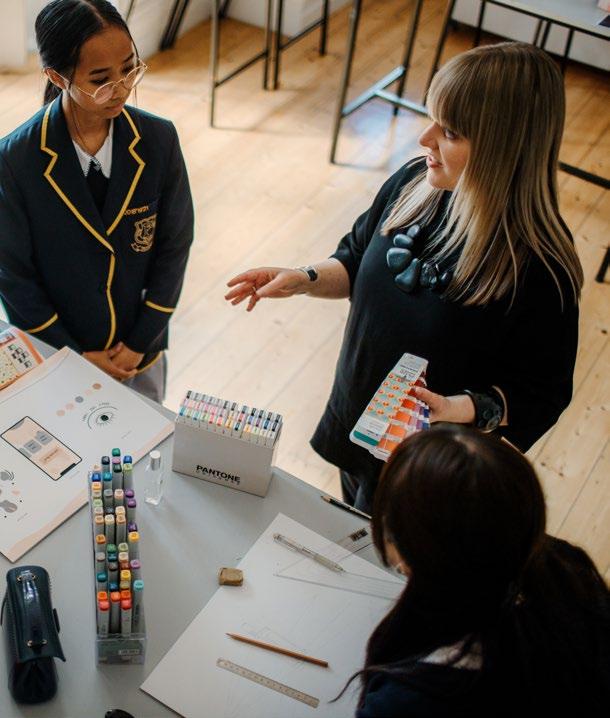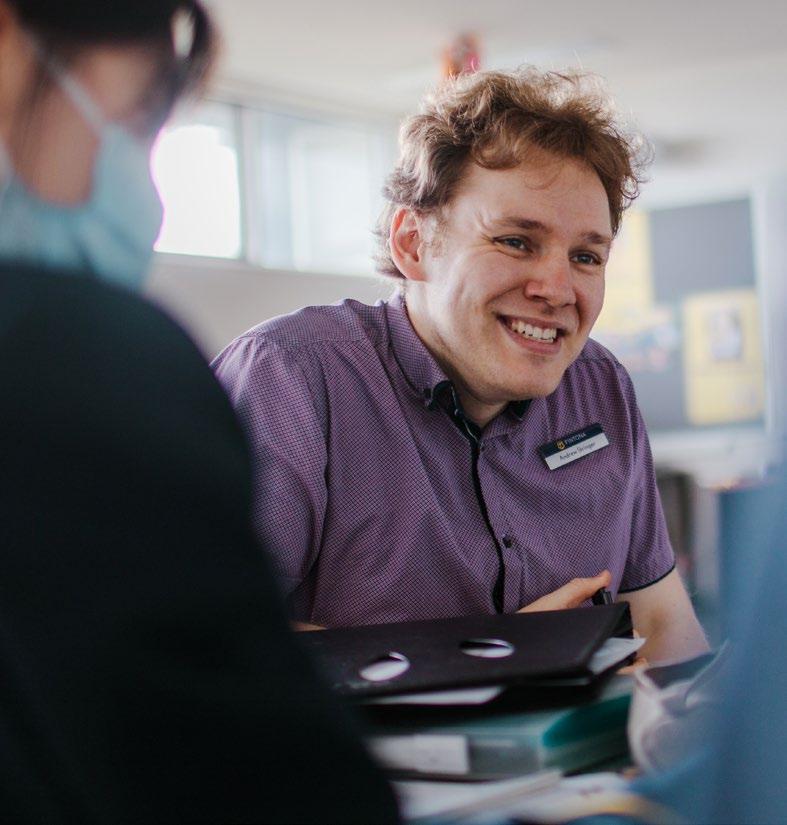
5 minute read
Meet our teachers
CLARE SANDERS
After studying Fashion Design at RMIT and working in brand management and design studios within the Australian fashion industry, Clare chose to become a teacher because, ‘Education is an oracle for future thinking.
At Fintona, Clare teaches VCE Visual Communication Design and Year 10 design focused electives including Fashion and Architecture.
What makes you so passionate about teaching design? My life is centred in the pursuit of design, culture and beauty. Teaching design is an embodied experience for me. You have a design practice outside of Fintona, could you tell us more about that? I design, pattern make and sew a range of garments. My designs are often an extension of my own style and pieces I would like to wear and have in my own wardrobe. My approach is to create new garment styles slowly and intentionally rather than in line with traditional fashion seasons, often my designs are made-toorder. I use deadstock fabric to minimise environmental impact. When designing garments my aesthetic interests are texture, sculptural forms and silhouettes, and consideration of modular garments that can sync with an existing wardrobe offering longevity and functionality. You will often see me wearing clothes I’ve designed and made, to work. I also work collaboratively with my mother on a range of jewellery.
How does this practice support your teaching? Maintaining a personal design practice is critical to my teaching practice. It allows me to empathise with students because I understand the creative process and the ebbs and flows of design thinking. Personal design practice also facilitates constant professional development. I believe visual arts educators are most powerful when there is a coalescence of practice and teaching. I am involved in the Melbourne Graduate School of Education TAP project, a longitudinal study on teacher participation in art and design practice.
Who and/or what inspires you? Lidewij Edelkoort. Vivienne Westwood. Central Saint Martins. The Venice Biennale. Museums and galleries. Some favourites are The Tate and the VandA in London, The Met and FIT in New York, MoMu Antwerp and Musée des Arts Décoratifs and Palais Galliera, Paris.
What do you hope the future of teaching art and design looks like? I hope there is enhanced scope for students to speculate and identify design opportunities, igniting their forecasting and forward thinking. Design has the power to improve quality of life, define our culture and address contemporary issues. We need to provide students the agency to experiment and deliver innovation.
ANDREW STRINGER
Andrew’s career as a teacher began when he was just 17, teaching swimming at the Kew Recreation Centre. After transitioning into a Master of Teaching at Melbourne University, he has never considered another career, ‘The idea of helping students to grow in specific skill sets has always been a delight for me. Whether it was correcting stroke technique, leading students to that grand epiphany behind a novel’s inner workings, or helping students to craft their written masterpieces, teaching has always given me a thrill.’ Andrew has been teaching English in the Middle and Senior School for eight years and says, ‘The School provides me the capacity to be the daft, eccentric English-mad person that I am.’ What makes you so passionate about English? The area of English I am most passionate about is the study of argument. We unpack how writers seek to persuade and convince readers of a particular contention, something that I think regardless of where Fintonians go post-schooling they will invariably come up against at some point in their lives. The critical thought that English encourages girls to look at persuasive writing with a level of critique, ensuring that they don’t take convincing words at face value, but take the time to be wary of what others may expect of them. This skill, I believe, is vital to helping people to be independent, confident and to express their views, recognising that the world may not necessarily agree with them, but that they are free to express those beliefs.
What is one thing you hope students remember from your classes? I hope the girls take from my class that self-respect comes from a passion for one’s
‘I have been a teacher all my life.’

interests. If you love what you do, pomp and circumstance are unimportant. Do what you love and do so without reservation or concern for dignity or what people might think or say about you. Dignity stems from the confidence to embrace your true passions.
What is it like to be in your class? Exhausting I should imagine. I am very conscious of the frenetic and energetic pace I charge through my lessons! I am frequently telling my students to arrest me should I go through the content too quickly, for when I get invested in an idea or concept from a text, I become incredibly excited and want to share with the students all the possible connections we might make. Similarly, I have been known to shriek with excitement when students offer unique insights into the content we work through, which can sometimes catch my students off guard. I frequently end classes feeling completely out of breath, and I hope my students may experience the same.
What are three books everyone needs to read and why? There are so many books I have loved with a burning passion, but when you ask which three people NEED to read…that’s a whole other kettle of fish.
Frankenstein. As most would know, it discusses the dangers of technological experimentation without restraint, but it is also so much more human than people realise. The creature’s abandonment and reflections on the very nature of being human is incredibly prolific.
The Great Gatsby. Fitzgerald unpacks the dangers of humanity’s lack of meaning or purpose behind a life dedicated to material ownership and how it can corrupt the human spirit to the point of selfdestruction.
Station Eleven. What I respect most about the text is its recognition that human society depends almost entirely on the connections formed between people. Yet these connections are unbelievably fragile and as a society we need to be conscious of the need to change values and beliefs as this societal structure is changed, reshaped, and nurtured to keep the human heart beating into the future.










